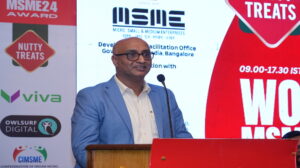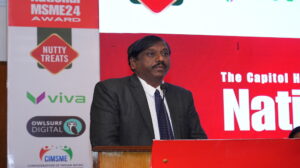GM just made a big behind-the-scenes move to boost robot cars

General Motors is moving its No. 2 executive, company President Dan Ammann, to be CEO of its self-driving unit, GM Cruise, as it aggressively pushes to bring the robot cars to market next year.
Starting Jan. 1, Ammann, 46, takes the helm of Cruise. Cruise cofounder, Kyle Vogt, 33, stays to lead technology development as Cruise president and chief technology officer.
The move underscores that even as GM announced five plant closings in North America this week and about 14,000 hourly and salaried job cuts by the end of next year to save it $6 billion, its commitment to electric and autonomous vehicle technology is unwavering.
The executive job shifts “demonstrate our commitment to transforming mobility through the safe deployment of self-driving technology and move us closer to our vision for a future with zero crashes, zero emissions and zero congestion,” GM Chairman and CEO Mary Barra said in a statement. “As we move toward commercial deployment, adding Dan to the strong team led by Kyle is the next step.”
Make it profitable
In an interview with the Free Press, Ammann said his experience is in finance and business operations, so his first task will be to figure out a business model that generates profits.
“That is a lot of my background, I will be bringing that with me,” said Ammann.
Ammann said his move also underscores the fact that Cruise is growing in importance in terms of investment and attention it gets from leaders inside GM.
“If you go back to first principles of why are we doing what we’re doing, it’s because we believe that autonomous vehicles have potential,” said Ammann. “We see this as an enormous opportunity that can have an enormous impact on the world.”
Ford has said it expects autonomous ride sharing and delivery to be a $300 billion a year industry. Ammann stopped short of agreeing with that figure, saying, “We haven’t put any specific numbers on it, but when you think about the fact that there are 3 trillion miles traveled a year in the U.S. — we see this as a gigantic opportunity.”
GM Cruise is critical to GM’s future, especially given the cost-cutting moves the company announced Monday. GM expects to save $6 billion by 2020, it said, allowing it to reinvest in future technology.
“Long term, Cruise is definitely their focus,” said Jeremy Acevedo, analyst with Edmunds. “Their portfolio and tradition business is still going to be critical. But long term their plan is autonomous vehicles.”
The right guy
Analysts said the move makes sense, offering up one way to make it profitable.
“Dan Ammann has been behind GM’s autonomous vehicle strategy from the start, so this is a logical step to have him head this growing entity,” said Michelle Krebs, executive analyst for Autotrader. “He will be able to push the business to move faster and go after funding and partnerships that are more Silicon Valley style than Detroit.”
As GM moves more toward commercializing the technology, Ammann is the right person to lead GM Cruise, said Sam Abuelsamid, senior analyst at Navigant Research in Ann Arbor.
“It’s not just the technology development anymore, there’s the business side of it,” said Abuelsamid. “This is the sort of thing we’ll see from other companies as they move forward in AV — setting up these separate business units — and it keeps Kyle focused on the technology side.”
The biggest challenge Ammann faces is figuring out how to make the billions invested in self-driving cars generate a profitable return.
“This is the challenge for every company in this space: Finding a model that other companies can follow, consumers would want to use and making it profitable because if it’s not profitable then it isn’t viable as a company,” said Abuelsamid.
Buying robot cars
Ammann, who hails from New Zealand, joined GM in 2010 from Morgan Stanley. He managed GM’s initial public offering after emerging from bankruptcy. In April 2011, he became GM’s CFO. He has served as GM’s president since 2014.
He was instrumental in GM’s purchase of Cruise in 2016 and has overseen GM’s relationship with Cruise ever since.
Cruise has rapidly expanded in the past 24 months. When GM bought it, 40 people worked there. Today, it employs about 1,000, many of whom Ammann is familiar with. He also understands its business operations and technology.
“I’m excited to dedicate 100 percent of my time and energy to helping Kyle and the entire team realize our mission of deploying this technology at scale,” Ammann said in a statement.
Vogt said he’s been working with Ammann since 2016 and is “thrilled” Ammann is joining Cruise full time to help Cruise commercially deploy the self-driving cars.
Growing the future
Ammann has also been key in securing two recent big cash infusions that will help to accelerate GM’s development of self-driving technology and get the robot cars to market in a commercial ride-sharing from next year.
In June, it announced a deal with SoftBank Vision Fund. SoftBank, a large Japanese technology investment company with stakes in such companies as Uber, will invest $2.25 billion in GM Cruise Holdings, and GM will invest $1.1 billion in GM Cruise.
Then in October, GM said it signed a deal to partner with Honda. Honda will contribute about $2 billion over 12 years to these goals. It will also finance a $750-million equity investment in Cruise, bringing its total commitment to the project to $2.75 billion.
The two deals bring the valuation of Cruise to $14.6 billion, Barra told reporters at the time.
GM Cruise is running neck-and-neck with Waymo, a subsidiary of Google, to be first to bring the robot car ride sharing to market. The two companies are considered the leaders in a crowded field, and San Francisco is the proving grounds to refine the technology.
The first Cruise AVs were Chevrolet Bolts, Chevrolet’s all-electric vehicle, that used two Lidar sensors on the roof. Last year, GM Cruise built 130 of the second generation of its AVs that had a bigger suite of sensors. Then, last fall, it added another 50 of the cars. GM no longer calls them Bolts, but rather the Cruise AV, he said.
All the self-driving cars are electric and still have operating controls, such as a steering wheel and brakes. They are being tested mostly in San Francisco, with a handful deployed in Milford and the Phoenix area.
GM did offer a peak of what its prototype self-driving car in October, but said many questions, such as where it will first be deployed and which plant will build it remain undecided.






